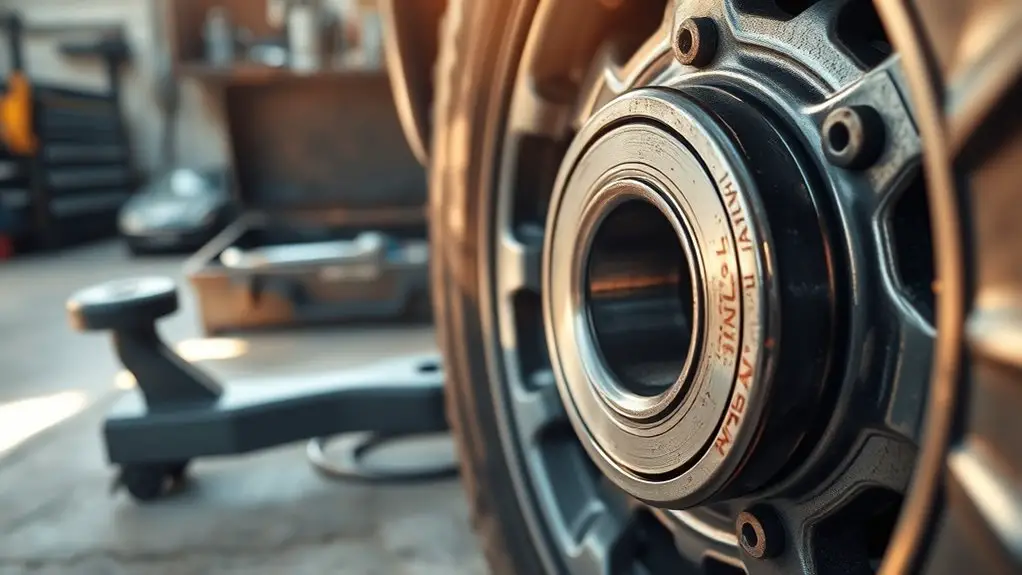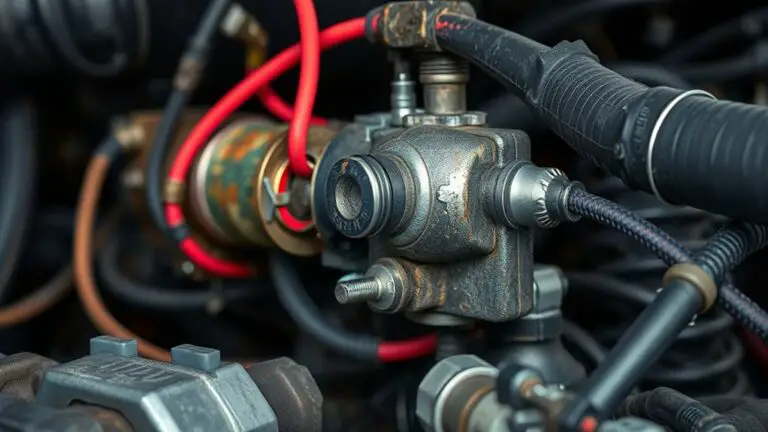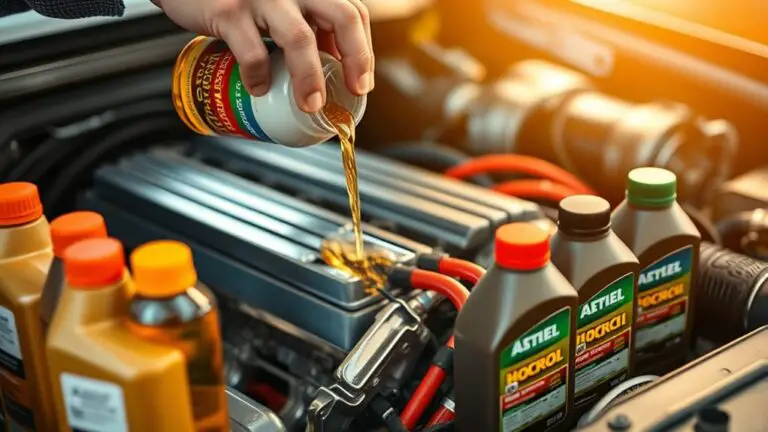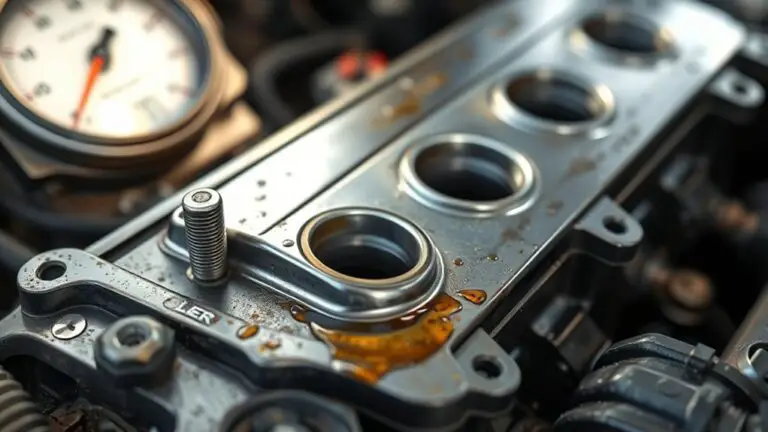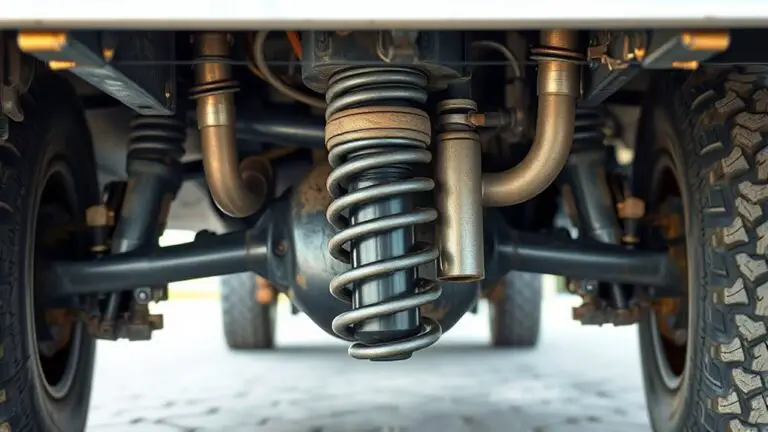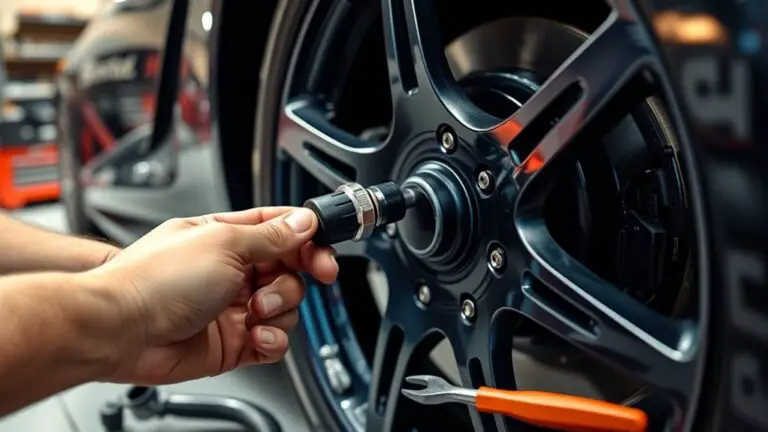How Load and Towing Lead to Wheel Bearing Noise and How to Fix Them
Load from towing increases axle bearing loads and heat, changing how the bearings run and often causing noise. Start with a systematic check: verify preload and hub torque to spec, guarantee proper lubrication volume and seals, and confirm correct wheel alignment and trailer tongue weight. Listen for low‑frequency rumble or growling that worsens with weight or speed, and note any steering changes. If issues persist, you’ll find targeted fixes and preventive steps ahead. You’ll discover more practical steps next.
Assessing How Towing Affects Wheel Bearings
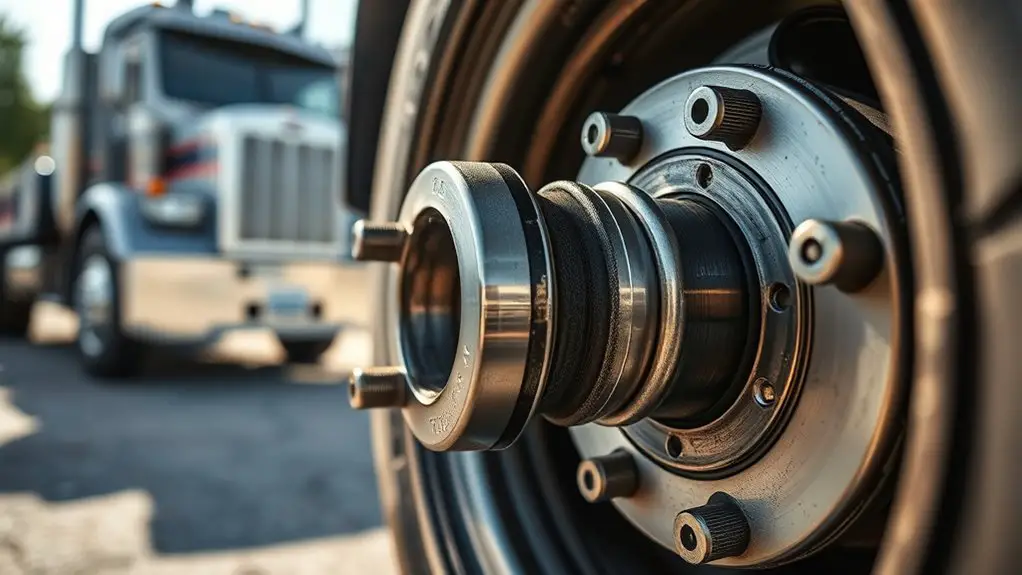
When towing, wheel bearings are subjected to increased loads and dynamic forces that can alter their behavior compared to unloaded conditions. You assess the effect by establishing towing limits informed by vehicle specifications, axle ratings, and trailer weight. Begin with load calculations: vehicle gross combined weight, trailer tongue weight, and hitch geometry determine sustained bearing load. Compare these values to bearing ratings and service manuals to identify margins or overages. Inspect axle housings, seals, and race surfaces for signs of excessive heat, wear, or moisture ingress that can amplify friction and noise. Implement bearing maintenance practices: guarantee correct lubrication type, adequate grease volume, and proper pre-load or spacer setpoints where applicable. Monitor temperature during initial towed runs and after long hauls; persistent heat indicates overload or insufficient lubrication. Document findings, adjust towing limits if necessary, and schedule proactive maintenance intervals to preserve bearing integrity and overall drivetrain reliability.
Signs Your Wheel Bearings Are Struggling Under Load
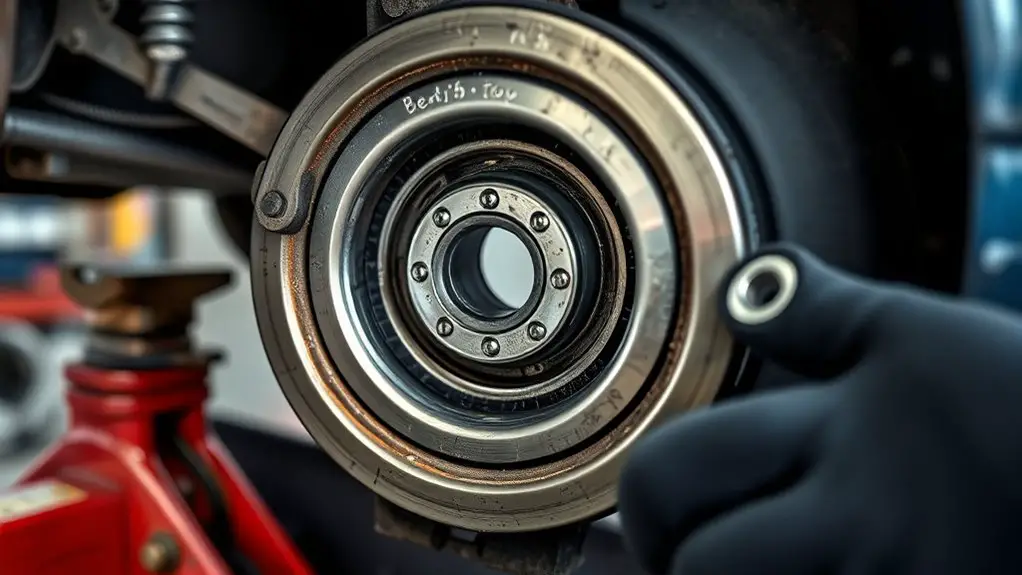
If wheel bearings are under load, you’ll notice specific, telltale signs that point to bearing struggle rather than other drivetrain faults. Begin with predictable patterns: continuous noise that shifts with speed, not engine RPM, and worsens under load — especially when towing or climbing grades. Listen for persistent low-frequency roar or grinding that doesn’t disappear on deceleration. Check for transient bumps that trigger a wave of noise, then fade; that pattern suggests bearing wear rather than tire or brake issues. Feel for steering feel changes: subtle play, or a slight dragging sensation, intensifying when weight is applied to the axle. Inspect for vibration transmitted through the pedal or steering wheel at certain speeds, aligned with load level. Look for bearing failure indicators in the hub area: warmth, uneven wheel looseness, or uneven heat after routine road testing. If noise symptoms persist under load, schedule inspection promptly to prevent progressive damage.
Why Load Changes Can Increase Bearing Heat
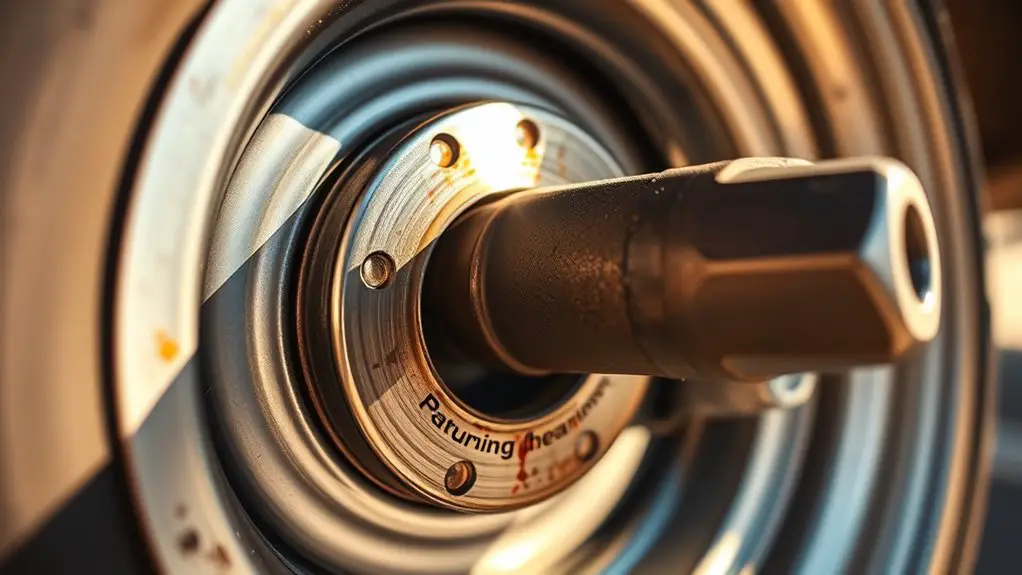
Load-induced heat rise occurs as bearing load shifts resistive friction and viscous losses, increasing generated heat at each revolution. Towing stress amplifies this effect by adding sustained load and dynamic braking forces, widening the bearing’s temperature envelope. Expect bearing temperature to vary with load and duty cycle, guiding you to monitor for unusual heat spikes and to route audits toward load management and cooling if needed.
Load-Induced Heat Rise
Even under steady road conditions, increasing load raises bearing temperatures because the frictional work rate grows with axle load. You’ll see heat rise from higher contact forces, extended contact paths, and intensified viscoelastic losses in seals. To manage this, apply disciplined load management: limit peak axle weights, distribute loads evenly, and monitor tire pressures to prevent localized hotspots. Understand that heat dissipation hinges on surface cooling paths, ambient conditions, and airflow around the housing. Improve dissipation by maintaining clean fins, ensuring proper breather operation, and avoiding debris buildup that blocks convection. Track bearing operating temperature and correlate it with load patterns, adjusting maintenance intervals accordingly. Practical guidance: design with margin, quantify heat rise per ton, and optimize distributions to sustain reliable performance.
Towing Stress Effects
Towing introduces additional dynamic loads that raise bearing stress and heat generation beyond steady-state conditions. When you tow, peak axle loads shift with pitching, braking, and gusts, stressing raceways and seals more than idle movement. Your towing capacity sets the upper bound of safe loading, but real-world stresses depend on how weight is carried. If load distribution is front-heavy, your tongue weight increases, altering shimmy tendencies and baseplate reaction forces, which elevates bearing friction. Conversely, rear-heavy setups reduce tongue pressure but introduce drum-like axle reactions that spike heat in inner races. To manage heat, monitor hitch alignment, verify even weight across axles, and adjust ballast so tongue weight stays within spec. Regular checks of bearing preload and lubrication remain essential as loads fluctuate during towing.
Bearing Temp Variance
Bearing temperature variance stems from how load changes alter heat generation and dissipation at the bearing interface. You’ll see higher temps when loads spike or oscillate, because increased or fluctuating friction raises energy loss that the lubricant and housing must shed. Systematically, assess the path of heat: contact stress, lubricant viscosity, clearance, and airflow. When you tow or carry heavy loads, expect transient peaks followed by gradual cooling as load stabilizes. Implement temp monitoring to capture peak values and duration, not just average temps. Use continuous sensors near the bearing race and seal, log excursions, and compare against baseline. If consistently elevated, inspect lubrication intervals, seal integrity, and mounting preload. Sustained high temps shorten bearing lifespan; proactive temperature monitoring guides timely maintenance decisions.
Identifying Noise Patterns Linked to Towing
While towing, certain noise patterns reliably indicate wheel bearing issues rather than other drivetrain sounds. You’ll focus on patterns that scale with speed, load, and steering input, then distinguish them from exhaust or suspension chatter. Precise listening over road texture helps, as does correlating sound with axle load changes.
1) A consistent low-frequency hum that rises with speed and remains present when coasting with no throttle.
2) A rhythmic rumble that intensifies under braking or after cornering, aligned with wheel rotation rather than engine RPM.
3) A faint grinding or growling that worsens with vehicle weight and towing patterns, disappearing briefly when a tire is heavy loaded or grip changes.
4) A metallic flutter or squeal at a specific speed range, disappearing when unloaded or with stabilizing tow, suggesting bearing cage or race contact.
Use these signals to guide inspections, confirming noise identification before disassembly.
The Role of Preload and Hub Tightness When Loaded
Preload sets the initial load path on the bearing and influences how it responds to additional weight when loaded, so you’ll want to quantify it before towing. Under load, hub tightness determines radial play and friction heat, which affect noise onset and wear patterns. Start by confirming the prescribed preload and hub torque, then monitor any changes in clearance or noise as payload changes.
Preload Effects on Load
Preload, or the initial axial load applied to a wheel bearing assembly, directly governs how tight the hub feels under load and how quickly the bearing elements settle into their race contact. When you load the system, preload effects translate into tangible changes in contact stress and rotational feel. You’ll notice how small adjustments shift performance, stability, and noise tendency under highway or tow loads. To picture it clearly:
1) preload adjustment alters hub preload path and lock-in sequence
2) bearing tolerance bounds determine permissible play under load
3) tightness under load influences ferrite and race seating time
4) improper preload produces uneven wear and squeal without corrective action
Focus on consistent preload adjustment within tolerance to maintain reliable operation and avoid premature wear.
Hub Tightness Under Load
Under load, hub tightness governs how quickly the bearing elements seat and how the contact stresses redistribute as the wheel bears weight or is towed. You must manage preload consistency to prevent uneven wear and noise. Tightness affects load distribution strategies: too loose invites chatter; too tight increases friction and heat. Use precise hub adjustment techniques to set a repeatable baseline and monitor changes during towing or braking. Regular checks after impacts or heavy loads prevent drift in preload, preserving race seating and seal integrity. Track temperature and runout as indicators of misalignment. For pragmatic maintenance, document torque values, wire-lock or thread-lock decisions, and immediate readjustment needs. Table below summarizes steps and checks for reliable performance.
| Step | Action | Target |
|---|---|---|
| 1 | Inspect | Bearing seal wear |
| 2 | Measure | Runout and backlash |
| 3 | Adjust | Preload torque |
Differentiating Wheel Bearing Noise From Other Issues
How can you tell wheel bearing noise from other drivetrain or suspension sounds? By isolating the signature, you win clarity: bearing noise is often rotational, speed-dependent, and persists regardless of road texture or braking cues. Use controlled tests and note patterns, not impressions. Common misconceptions reappear here: tire noise, CV joints, and differential whine can mimic bearings but differ in causality and response.
Bearing noise is rotational, speed-dependent, and persists across road textures and braking cues.
- Rotation-synced hum versus intermittent clunk: bearings sustain a steady tone; loose or damaged components create jumps.
- Speed dependence: bearing noise climbs with velocity, not engine rpm alone.
- Load and cornering behavior: noise amplifies under load or at specific steering inputs, not during idle coasting.
- Temperature and duration: bearings may worsen as they heat, while other issues vary with speed or bump frequency.
Diagnosing noises demands careful elimination. Rely on methodical checks, avoid assuming bearing failure—common misconceptions seed improper repairs.
Steps to Inspect Bearings Before and After Hauling
Before you haul, perform a pre-haul bearing check by inspecting for play, roughness, and audible rough spots, and verify lubrication and seal integrity. After hauling, conduct a post-haul inspection to compare bearing feel and noise with the baseline, recheck mounting hardware, and confirm no new leaks or heat signs. Use consistent criteria to document findings and determine if any bearings require service or replacement before the next load.
Pre-haul Bearing Check
Pre-haul bearing checks guarantee you identify wear, looseness, or contamination before you tow. You’ll run a structured pre haul checklist to verify reliability and freedom on the road.
- Inspect wheel and hub for scoring, leaks, or corrosion, noting any abnormal play.
- Check wheel bearing lubrication levels and grease condition; repack if needed with manufacturer spec.
- Verify axle seal integrity and absence of moisture or debris in the bearing cavity.
- Test rotation for smoothness, noting any roughness, binding, or audible grinding.
Use deliberate torque values on fasteners, and document findings for post-haul comparison. Adhere to bearing lubrication intervals, and replace bearings showing wear signs. This methodical check reduces surprises, extends service life, and supports confident towing.
Post-haul Bearing Inspection
Post-haul bearing inspection focuses on confirming that bearings remain serviceable after a towing cycle and documenting any changes for maintenance planning. You approach this step with a disciplined checklist: verify bearing alignment visually and with runout gauges, then rotate the hub to listen for roughness or inconsistent drag. Record lubrication quality—check for adequate film, distant or contaminated grease, and signs of overheating. Inspect seals for leaks and any axial play that exceeds spec. Compare current readings to pre-haul baselines, noting deviations and their potential causes. If misalignment or degraded lubrication is found, adjust or re-lubricate according to the maintenance protocol, and schedule a follow-up check. This procedure yields actionable data for preventive maintenance and reduces the risk of post-haul failures.
Repair and Replacement Options for Damaged Bearings
If bearing damage is evident or suspected from load and towing conditions, repair and replacement options must be evaluated systematically to restore safety and performance. You should assess bearing types and determine whether repair or full replacement best fits your constraints, including uptime and long-term reliability. Consider these actionable steps:
1) Identify damage extent: pitting, wear, or looseness, to decide on bearing repair versus complete unit replacement.
2) Compare replacement costs versus repair feasibility, including labor, parts, and potential driveline adjustments.
3) Choose matched assemblies when possible to preserve axial and radial alignment and minimize vibration risks.
4) Plan installation steps with torque specs, lubrication needs, and road-test checks to confirm restored bearing performance and quiet operation.
In practice, prioritize reliability and predictable performance over minimal upfront spending, and document the chosen path for future maintenance.
Preventive Measures to Minimize Bearing Problems During Towing
When towing, small bearing issues can escalate quickly if not proactively managed, so preventive steps should follow from the previous focus on repair and replacement by emphasizing reliability and predictable performance. You enforce this with a disciplined preventive maintenance routine before every trip. Inspect hubs, seals, and grease intervals, and verify bearing preload and torque specs are within manufacturer guidelines. Apply proper lubrication using the recommended grease type and maintain clean, contamination-free fittings. Adopt precise towing techniques: steady accelerations, gradual braking, and balanced loads to minimize dynamic shocks that stress bearings. Track axle temperatures with an infrared meter during the warm-up phase and after climbs to detect abnormal heat early. Replace worn raceways, seals, or drums before they become unsafe, and maintain correct wheel-end alignment to prevent uneven wear. Document mileage, load, and service actions to support predictable performance and rapid fault isolation for future trips.
Maintenance Habits for Long-Term Bearing Health
Maintenance habits for long-term bearing health require a disciplined, data-driven routine that you perform between trips and across seasons. You’ll establish predictable patterns that minimize variability and extend bearing life through consistent actions and record-keeping.
1) Follow a defined bearing lubrication schedule, using manufacturer-approved grease and timing to prevent starvation or over-greasing.
2) Inspect seals, hubs, and races at each service interval, noting wear, leaks, or contamination and addressing issues before they escalate.
3) Track vehicle payloads and towing loads, adjusting maintenance schedules to reflect actual stress and heat exposure on bearings.
4) Log operating conditions and service outcomes, creating a feedback loop that refines procedures and flags patterns before failures emerge.
These habits support bearing lubrication effectiveness and durable maintenance schedules, reducing squeal, vibration, and downtime while preserving freedom to roam.
Frequently Asked Questions
Can Towing Load Cause Bearing Failure Without Obvious Noise?
“Read between the lines” rings true: yes, towing load can cause bearing failure without obvious noise. You should monitor bearing temperature, play, and radial endfloat, especially if towing near or beyond your towing capacity. Regular bearing maintenance, check hubs, seals, and grease, and replace worn components before symptoms appear. If you suspect overload, reduce load, recheck weight distribution, and verify trailer alignment. Systematically test, document, and maintain to prevent silent failures.
Do Wheel Bearings Wear Differently Under Constant vs. Intermittent Tow?
Yes, wheel bearings wear differently: constant load effects cause steady wear patterns, while intermittent stress impacts induce peak loading moments and micro-delamination. You’ll observe smoother wear under constant tow, and spiky wear with irregular towing. Monitor for heat and play. Maintain lubrication and bearings within spec. Track vibration signatures, and schedule inspection after sustained pulls. You’ll benefit from load management, evenly distributed weight, and braking cadence that lowers peak torque and reduces wear risk.
How Quickly Do Bearings Deteriorate Under Heavy Towing Loads?
Bearing lifespan under heavy towing deteriorates more quickly than light loads, but rate depends on weight, speed, and axle design; expect accelerated wear within months to a few thousand miles if sustained. The load impact is nonlinear: marginal increases can dramatically shorten life if cooling, lubrication, and alignment aren’t ideal. You should monitor temps, axle wobble, and bearing play, rotate loads, and service lubrication regularly to mitigate rapid deterioration. Maintain conservative towing limits and verify wheel bearings periodically.
Can Steering Feel Changes Indicate Bearing Issues During Towing?
Yes, steering feel changes can indicate bearing issues during towing. You’ll notice vague or gritty steering, uneven drift, or increased pull if load distribution shifts. Start by checking tire pressures, wheel alignment, and axle preload, then monitor steering feedback over varying speeds and loads. Systematically verify with a torque check and bearing temperature readings. If anomalies persist, don’t delay; address bearings, hubs, or suspension components to restore precise steering and safe load handling.
Are There Signs of Axle or Hub Damage Mistaken for Bearing Noise?
Yes—axle or hub damage can masquerade as bearing noise. You should perform a careful axle inspection and check hub alignment first, since misalignment or bent components amplify noise. Look for irregular play, uneven tire wear, and looseness at studs. If sounds persist under deceleration, torque, or weight shifts, suspect a damaged axle or hub, not just bearings. Document findings, compare to specs, and test with calibrated indicators to confirm.

